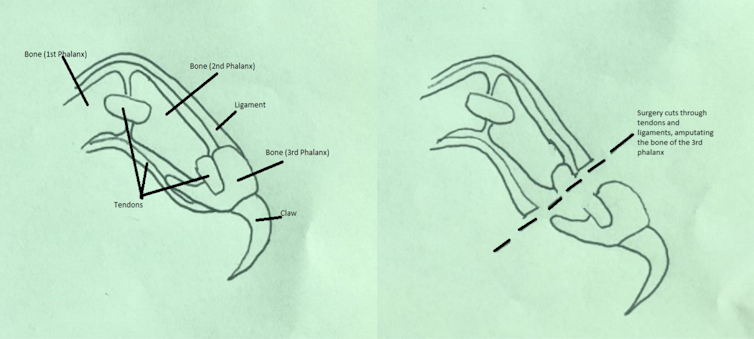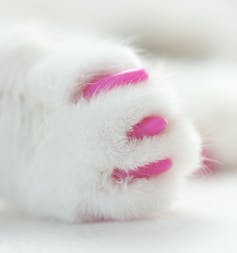Curious Kids: How are cats declawed, and is it painful?
- Written by Ilana Halperin, Health Sciences Assistant Clinical Professor in Community Practice, School of Veterinary Medicine, University of California, Davis
 Curious Kids[1] is a series for children of all ages. If you have a question you’d like an expert to answer, send it to curiouskidsus@theconversation.com[2].
Declawing a cat might sound as simple as trimming your pet’s nails. But it’s actually major surgery.
A veterinarian cuts through the joint to amputate part of the cat’s toes, from the last knuckle out to the tip of the claw.
Curious Kids[1] is a series for children of all ages. If you have a question you’d like an expert to answer, send it to curiouskidsus@theconversation.com[2].
Declawing a cat might sound as simple as trimming your pet’s nails. But it’s actually major surgery.
A veterinarian cuts through the joint to amputate part of the cat’s toes, from the last knuckle out to the tip of the claw.
 Declawing amputates the bone at the tip of the cat’s paw along with the claw.
Ilana Halperin, CC BY-ND[3]
Scratching things is a natural behavior for cats[4]. It lets them get healthy stretching exercise and also provides stress relief.
A cat might accidentally scratch you while playing. Or a cat might aggressively lash out with its claws. A pet owner usually chooses onychectomy, as declawing surgery is technically called, to prevent scratching injuries to people or damage to objects.
Declawing will not address the real issue causing a cat to behave aggressively, so the risk of injury from biting remains. One study found that almost 50% of cats occasionally display aggression[5] toward both people they know and strangers.
This surgery comes with risks of complications. Right after being declawed, the cat will be in pain[6]. Vets will prescribe medicine to help manage the immediate pain[7]. There may also be bleeding, swelling and infection.
One study found that 42% of declawed cats had ongoing long-term pain[8] and about a quarter of declawed cats limped. In up to 15% of cases, the claws can eventually regrow[9] after the surgery.
Once a cat is declawed, it must stay indoors only. Removing the claws removes the cat’s main way to defend itself and climb well.
Some pet owners see declawing as their last option before getting rid of a cat that scratches. The American Veterinary Medical Association “strongly encourages[10]” people to learn more about the procedure before signing a cat up. It’s possible an owner might not understand normal scratching behavior or how serious the surgery is.
Many veterinarians, including me, do not perform declawing surgery. In most cases it’s because they feel the elective procedure is not medically necessary and that it’s not a humane choice for cats.
Declawing is illegal in some American cities, including Los Angeles and Denver, and the state of New York. The U.K., Australia and many parts of the European Union and Canada have also outlawed declawing[11].
Declawing amputates the bone at the tip of the cat’s paw along with the claw.
Ilana Halperin, CC BY-ND[3]
Scratching things is a natural behavior for cats[4]. It lets them get healthy stretching exercise and also provides stress relief.
A cat might accidentally scratch you while playing. Or a cat might aggressively lash out with its claws. A pet owner usually chooses onychectomy, as declawing surgery is technically called, to prevent scratching injuries to people or damage to objects.
Declawing will not address the real issue causing a cat to behave aggressively, so the risk of injury from biting remains. One study found that almost 50% of cats occasionally display aggression[5] toward both people they know and strangers.
This surgery comes with risks of complications. Right after being declawed, the cat will be in pain[6]. Vets will prescribe medicine to help manage the immediate pain[7]. There may also be bleeding, swelling and infection.
One study found that 42% of declawed cats had ongoing long-term pain[8] and about a quarter of declawed cats limped. In up to 15% of cases, the claws can eventually regrow[9] after the surgery.
Once a cat is declawed, it must stay indoors only. Removing the claws removes the cat’s main way to defend itself and climb well.
Some pet owners see declawing as their last option before getting rid of a cat that scratches. The American Veterinary Medical Association “strongly encourages[10]” people to learn more about the procedure before signing a cat up. It’s possible an owner might not understand normal scratching behavior or how serious the surgery is.
Many veterinarians, including me, do not perform declawing surgery. In most cases it’s because they feel the elective procedure is not medically necessary and that it’s not a humane choice for cats.
Declawing is illegal in some American cities, including Los Angeles and Denver, and the state of New York. The U.K., Australia and many parts of the European Union and Canada have also outlawed declawing[11].
 Frequent nail trimming and protective nail caps can go a long way toward cutting down on scratching damage.
Alena Ozerova/Shutterstock.com[12]
If you have a cat that just won’t stop scratching, there are some other solutions. Frequent nail trimming and the use of plastic nail caps over the cat’s claws can help. Offering scratching posts and other forms of environmental enrichment[13] can also reduce scratch damage. Veterinarians can prescribe therapies to reduce feline anxiety, too, including medications and pheromone diffusers that spread calming chemicals that cats naturally release.
Living with a cat comes with the responsibility to keep that pet healthy and content. That means finding a fair balance between protecting the health of family members and that of the household cat. It may also mean coming to terms with the idea that some cats express their normal need to scratch on the furniture. Fortunately, veterinarians are available to discuss options to keep everyone in the household comfortable and happy.
Hello, curious kids! Do you have a question you’d like an expert to answer? Ask an adult to send your question to curiouskidsus@theconversation.com[14].
Please tell us your name, age and the city where you live. We won’t be able to answer every question, but we will do our best.
Frequent nail trimming and protective nail caps can go a long way toward cutting down on scratching damage.
Alena Ozerova/Shutterstock.com[12]
If you have a cat that just won’t stop scratching, there are some other solutions. Frequent nail trimming and the use of plastic nail caps over the cat’s claws can help. Offering scratching posts and other forms of environmental enrichment[13] can also reduce scratch damage. Veterinarians can prescribe therapies to reduce feline anxiety, too, including medications and pheromone diffusers that spread calming chemicals that cats naturally release.
Living with a cat comes with the responsibility to keep that pet healthy and content. That means finding a fair balance between protecting the health of family members and that of the household cat. It may also mean coming to terms with the idea that some cats express their normal need to scratch on the furniture. Fortunately, veterinarians are available to discuss options to keep everyone in the household comfortable and happy.
Hello, curious kids! Do you have a question you’d like an expert to answer? Ask an adult to send your question to curiouskidsus@theconversation.com[14].
Please tell us your name, age and the city where you live. We won’t be able to answer every question, but we will do our best.
References
- ^ Curious Kids (theconversation.com)
- ^ curiouskidsus@theconversation.com (theconversation.com)
- ^ CC BY-ND (creativecommons.org)
- ^ natural behavior for cats (www.vet.cornell.edu)
- ^ almost 50% of cats occasionally display aggression (doi.org)
- ^ the cat will be in pain (doi.org)
- ^ immediate pain (www.ncbi.nlm.nih.gov)
- ^ 42% of declawed cats had ongoing long-term pain (www.ncbi.nlm.nih.gov)
- ^ claws can eventually regrow (doi.org)
- ^ strongly encourages (www.avma.org)
- ^ outlawed declawing (www.mycatsite.com)
- ^ Alena Ozerova/Shutterstock.com (www.shutterstock.com)
- ^ environmental enrichment (indoorpet.osu.edu)
- ^ curiouskidsus@theconversation.com (theconversation.com)
Authors: Ilana Halperin, Health Sciences Assistant Clinical Professor in Community Practice, School of Veterinary Medicine, University of California, Davis
Read more http://theconversation.com/curious-kids-how-are-cats-declawed-and-is-it-painful-119579

